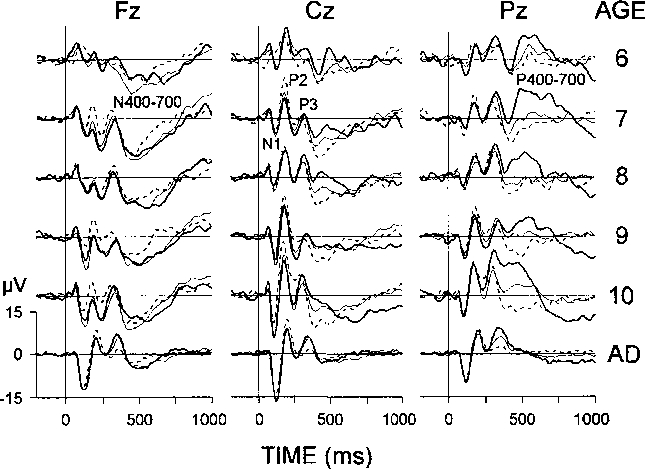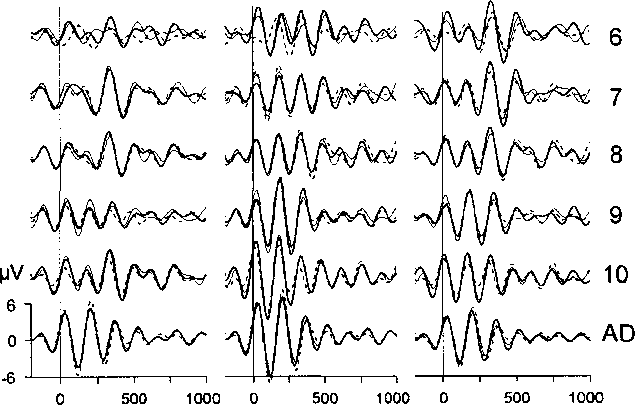118
JULIANA YORDANOVA, VASIL KOLEV
- - - PASSIVE — NONTARGET — TARGET

Figure 2 Grand average passive,
nontarget, and target ERPs at three
electrode locations (Fz, Cz, Pz)
from different age groups: 6-year-
olds, 7-year-olds, 8-year-olds, 9-year-
olds, 10-year-olds, AD - adults. Each
age group consists of 10 subjects.
Stimulus presentation is at Oms.
---PASSIVE —NONTARGET —TARGET
Fz Cz Pz AGE

TIME (ms)
Figure 3 Grand average passive,
nontarget, and target ERPs at three
electrode locations (Fz, Cz, Pz) fil-
tered in the theta (4-7 Hz) range.
The age groups are as designated in
Figure 2.
(group means of 6-, rl-, 8-, 9-, and 10-year-old
children: 716,702, 675, 602,472 ms respective-
ly), but were significantly slower than those of
adults (mean 390ms). RTs did not differ be-
tween the groups of 6-8-year-olds, who also
manifested significantly slower responses than
9-10-year-old children. Error rate was higher
in children relative to adults, but this difference
was not significant.
Time domain averaged ERPs
Time domain ERPs are presented to illustrate
that the present data are consistent with previ-
ous results obtained with the classical ERP
method. Figure 2 shows that the ERPs of both
children and adults were characterized by N1,
P2, N2, and P3 (P300) components. Children
additionally displayed a frontal late negative
wave N400-700, and a parietal late positive
More intriguing information
1. The name is absent2. Pricing American-style Derivatives under the Heston Model Dynamics: A Fast Fourier Transformation in the Geske–Johnson Scheme
3. The Values and Character Dispositions of 14-16 Year Olds in the Hodge Hill Constituency
4. The constitution and evolution of the stars
5. TOWARD CULTURAL ONCOLOGY: THE EVOLUTIONARY INFORMATION DYNAMICS OF CANCER
6. The name is absent
7. The Impact of EU Accession in Romania: An Analysis of Regional Development Policy Effects by a Multiregional I-O Model
8. Foreign direct investment in the Indian telecommunications sector
9. Gianluigi Zenti, President, Academia Barilla SpA - The Changing Consumer: Demanding but Predictable
10. The name is absent